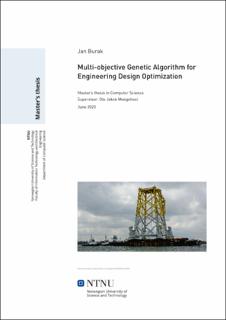| dc.contributor.advisor | Mengshoel, Ole Jakob | |
| dc.contributor.author | Burak, Jan | |
| dc.date.accessioned | 2021-09-15T16:07:05Z | |
| dc.date.available | 2021-09-15T16:07:05Z | |
| dc.date.issued | 2020 | |
| dc.identifier | no.ntnu:inspera:57320302:20936889 | |
| dc.identifier.uri | https://hdl.handle.net/11250/2777615 | |
| dc.description.abstract | Denne rapporten utforsker hvordan evolusjonær databehandling metoder blir brukt for strukturell optimalisering, med et fokus på bruk av genetiske algoritmer til design av jacketer. Jacketer er fagverksplattformer bygget i stål, som brukes som understøtte for oljeplattformer og vindmøller. Høye kostander av materialet, bygging, og installering, motiverer forsøk på å redusere størrelsene og antallet av elementer i konstruksjonene. Bedriften Kværner har utviklet et system som anvender en genetisk algoritme til å optimalisere designer. Denne rapporten forklarer teorien bak problemet og gir et sammendrag av relaterte prosjekter. Prosjektet utvider optimaliseringssystemet ved å anvende Non-Dominated Sorting Genetic Algorithm (NSGA-II), og sammenligner den med eksisterende implementasjonen av den genetiske algoritmen. Den nye strategien klarte å forbedre designer, men videre arbeid trenges til å produsere konstruksjoner som samsvarer med designkravene. Det ble også oppdaget at begrensningshåndtering mekanismen til NSGA-II fungerer dårlig med ugyldige løsninger. Til slutt presenteres forslag til forbedringer av systemet. | |
| dc.description.abstract | This report explores how evolutionary computation methods are applied in the field of structural design optimization with a focus on jacket optimization with a genetic algorithm. Jackets are steel towers supporting offshore installations such as oil platforms and wind turbines. Due to high costs associated with material, construction, and installation, there is an interest in decreasing the number, as well as the sizes, of elements in jacket designs. To this end, company Kværner has developed a system employing a genetic algorithm to optimize designs. This report explains the underlying concepts relating to the problem, and explores previous related studies. The project extends the optimization system by employing the Non-Dominated Sorting Genetic Algorithm (NSGA-II), and comparing it to the existing implementation of a genetic algorithm. The new approach managed to show design improvement, but further work is needed to produce designs conforming to engineering rules. It has also been found that the constraint handling method of NSGA-II navigates poorly in the infeasible space. Finally, suggestions for future work are discussed. | |
| dc.language | | |
| dc.publisher | NTNU | |
| dc.title | Multi-objective Genetic Algorithm for Engineering Design Optimization | |
| dc.type | Master thesis | |
